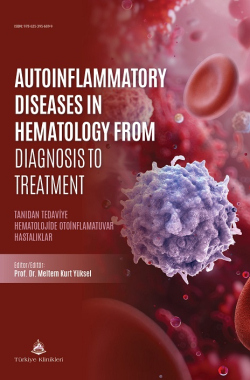HEMATOPOIEITC STEM CELL TRANSPLANTATION IN IHD
INTRODUCTION
Inflammation is a complex physiological process that protects the body from infections and injuries. However, uncontrolled activation of inflammation can lead to diseases, organ damage, and even death. The foundation of the inflammatory process is the IL-1b/IL-6/Creactive protein (CRP) axis, which is often a therapeutic target in many auto-inflammatory diseases. To summarize this axis in its simplest form, bacterial infections lead to the release of IL-1b from macrophages. IL-1, in turn, causes the production of IL-6, and this process results in an increase in CRP.1
Recently, clinical and genetic developments have also led to advancements in the diagnosis and treatment of hematological inflammatory diseases. Examples of these diseases include monogenic inflammatory diseases (example, VEXAS syndrome), cytokine release syndromes (example, hemophagocytic lymphohistiocytosis), and monoclonal and polyclonal hypergammaglobulinemias (example, Rosai-Dorfman syndrome). The identification of these diseases and the differential diagnosis provides clinical benefit in terms of treatment and follow-up, but these entitties can be co-associated, and it may not always be possible to make a differential diagnosis.1,2
The treatments for these auto-inflammatory diseases differ from those for other hematological malignancies. Specifically, the uncontrolled activation of the IL-1b/IL-6/CRP axis, which contributes to the physiological response to infections, forms the basis for the organ and tissue damage that occurs in this group of diseases.3 In light of this information, treatments are aimed at suppressing this axis at various steps. Corticosteroids may be used in the treatment of this disease group due to their immunosuppressive effects. Additionally, targeted therapies that inhibit the activation of this axis have gained prominence in recent years. Anakinra, an IL-1 receptor blocker, is the most commonly used treatment option for this purpose. Tocilizumab, an IL-6 blocker, is another option that can be applied in selected cases, particularly in cytokine release syndrome. JAK inhibitors, which block the Jak/Stat pathway to suppress inflammation, have been used in cases resistant to first-line therapies.1,2,4
Moreover, hematopoietic stem cell transplantation, which is used in other hematological malignancies, may also be applied in selected cases of VEXAS syndrome and MDS-associated auto-inflammatory diseases.1,5
Assoc. Prof. Dr. Asu Fergün Yılmaz
Marmara University, Faculty of Medicine,
Department of Hematology,
İstanbul, Türkiye
Referanslar
- Henrie R, Cherniawsky H, Marcon K, et al. Inflammatory diseases in hematology: a review. Am J Physiol Cell Physiol. 2022;323(4):C1121-C1136. [Crossref] [PubMed]
- Grignano E, Jachiet V, Fenaux P, Ades L, Fain O, Mekinian A. Autoimmune manifestations associated with myelodysplastic syndromes. Ann Hematol. 2018;97(11):2015-2023. [Crossref] [PubMed]
- Vergneault H, Picard C, Georgin-Lavialle S. Break down the barriers of auto-inflammation: how to deal with a monogenic auto-inflammatory disease and immuno-haematological features in 2022? Immunology. 2023;168(1):1-17. [Crossref] [PubMed]
- Al-Hakim A, Mistry A, Savic S. Improving diagnosis and clinical management of acquired systemic autoinflammatory diseases. J Inflamm Res. 2022;15:5739-5755. [Crossref] [PubMed] [PMC]
- Heiblig M, Patel B, Jamilloux Y. VEXAS syndrome, a new kid on the block of auto-inflammatory diseases: a hematologist's point of view. Best Pract Res Clin Rheumatol. 2023;37(1):101861. [Crossref] [PubMed]

